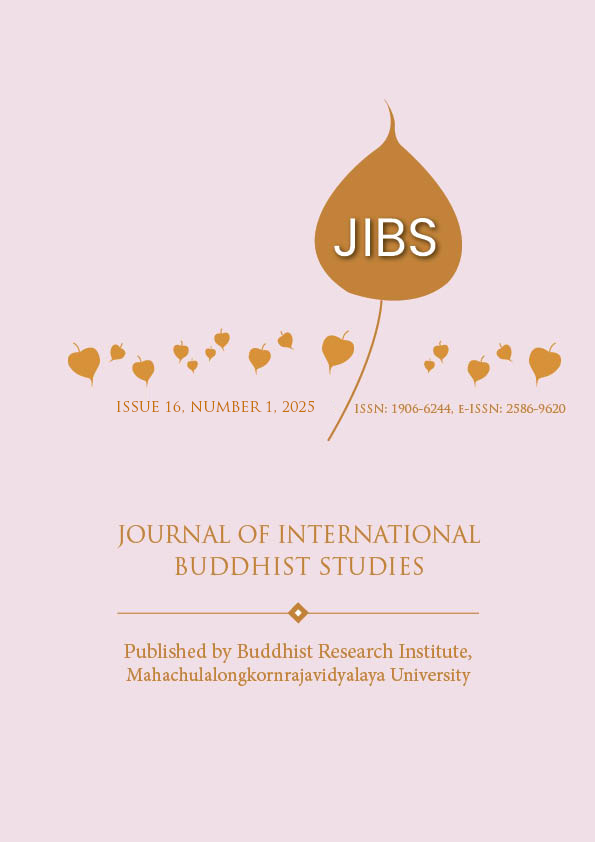Buddhist Principles in Urban Livability Assessment: A Thematic Analysis of Integration Approaches in Contemporary Research (2015-2024)
DOI:
https://doi.org/10.5281/zenodo.15788894Keywords:
Urban livabilit, Buddhist Principles, Assessment frameworks, Sustainable development, Urban planning, Cultural integration, Environmental governanceAbstract
This paper explores the integration of Buddhist philosophies into urban livability assessment frameworks through analysis of literature from 2015-2024. While traditional measurements rely primarily on quantitative metrics, Buddhist principles offer broader perspectives for addressing urbanization challenges, climate change, and inequality. Our methodology employed systematic literature review, thematic content analysis, and comparison of implementation patterns across urban settings. We analyzed academic texts, policy documents, and case studies on Buddhist concepts in urban contexts, focusing on principles like interconnectedness, mindfulness, ethical conduct, and the middle way. The research identifies implementation challenges and opportunities across regions, with traditionally Buddhist areas showing higher adoption rates, though principles remain universally applicable. Cities with strong institutional support demonstrate higher implementation success. Our framework links Buddhist values to specific urban applications, evaluation criteria, implementation challenges, and benefits. Interconnectedness (paticca samuppada) informs neighborhood designs that reduce travel time and foster social interactions. Mindfulness (sati) creates spaces that reduce stress, while compassion (karuna) manifests in inclusive housing policies that decrease homelessness and improve public health. Environmental assessment components align with Buddhist teachings on stewardship and human-nature interconnectedness. This research bridges ancient insights with contemporary urban challenges, offering practical guidance for urban planners seeking to create more sustainable, equitable, and spiritually enriching urban environments.
References
Abeydeera, Sanjee, Kearins, Kate and Tregidga, Helen. “Buddhism, Sustainability and Organizational Practices: Fertile Ground?” Journal of Corporate Citizenship 61 (2016) : 44-70. https://doi.org/10.9774/GLEAF.4700.2016.ma.00005.
Al-Bakry, Hiyam M.J., Mahmoud, Khawola F., and Altuhafi, Assda A. “The impact of the religious thought and beliefs on the sustainability of urban process and production.” International Journal of Sustainable Development and Planning, 17 (2022): 895–905. https://doi.org/10.18280/ijsdp.170319.
Anciaes, Paulo R., and Jones, Peter. “Transport Policy for Liveability: Valuing the Impacts on Movement, Place, and Society.” Transportation Research Part A: Policy and Practice 132 (2020): 157-173. https://doi.org/10.1016/j.tra.2019.11.009.
Antognelli, Sara, and Marco Vizzari. “Ecosystem and Urban Services for Landscape Livability: A Model for Quantification of Stakeholders’ Perceived Importance.” Land Use Policy 50 (2016): 277-292. https://doi.org/10.1016/j.landusepol.2015.09.023.
Asian Development Bank. Creating Livable Cities: Regional Perspectives. Asian Development Bank, 2019.
Brovarone, Elisabetta V., Scudellari, Jacopo, and Staricco, Luca. “Planning the Transition to Autonomous Driving: A Policy Pathway Towards Urban Liveability.” Cities 108 (2021): 102996. https://doi.org/10.1016/j.cities.2020.102996.
Daniels, Peter L. “Climate Change, Economics and Buddhism—Part 1: An Integrated Environmental Analysis Framework.” Ecological Economics 69, no. 5 (2010): 952-961. https://doi.org/10.1016/j.ecolecon.2009.12.002.
Daniels, Peter L. “Climate Change, Economics and Buddhism—Part 2: New Views and Practices for Sustainable World Economies.” Ecological Economics 69, no. 5 (2010): 962-972. https://doi.org/10.1016/j.ecolecon.2010.01.012.
Dena, Ashmaul M., and Haque,Khandoker W. “Ethical Leadership and Cultural Values: The Role of Buddhism in Shaping Modern Business.” Asian Review of Social Sciences, 13 (2024):17–22. https://doi.org/10.70112/arss-2024.13.1.3909.
Elshater, Abeer, Abusaada, Hisham and Afifi, Samy. “What Makes Livable Cities of Today Alike? Revisiting the Criterion of Singularity Through Two Case Studies.” Cities 92 (2019): 273-291. https://doi.org/10.1016/j.cities.2019.04.008.
Fu, Panpan, Ren, Yi-Shuai, Tian, Yonggang, Narayan, Seema W., and Weber, Olaf. “Reexamining the Relationship between ESG and Firm Performance: Evidence from the Role of Buddhism.” Borsa Istanbul Review 24 (2024): 47-60. https://doi.org/10.1016/j.bir.2023.10.011.
Global Platform for Sustainable Cities, and World Bank. Urban Sustainability Framework.World Bank, 2018.
Gur, Volkan T., and Tomashevskiy, Andrey. Taking sides: Corporate social responsibility and political ideology. Economics and Politics, 36 (2024): 1321–1344. https://doi.org/10.1111/ecpo.12288.
Hooper, Paula, Boruff, Bryan, Beesley, Bridget, Badland, Hannah, Giles-Corti, Billie. “Testing Spatial Measures of Public Open Space Planning Standards with Walking and Physical Activity Health Outcomes.” Landscape and Urban Planning 171 (2018): 57-67. https://doi.org/10.1016/j.landurbplan.2017.12.001.
Kaal, Harm. “A Conceptual History of Livability: Dutch Scientists, Politicians, Policy Makers and Citizens and the Quest for a Livable City.” City 15(2011): 532–547. https://doi.org/10.1080/13604813.2011.595094.
Mahmoudi, Mohammad, Farzaneh Ahmad, and Bushra Abbasi. “Livable Streets: The Effects of Physical Problems on the Quality and Livability of Kuala Lumpur Streets.” Cities 43 (2015): 104-114. https://doi.org/10.1016/j.cities.2014.11.016.
Martiny, Anna, Taglialatela, Jonathan, Testa, Francesco and Iraldo, Fabio. “Determinants of Environmental Social and Governance (ESG) Performance: A Systematic Literature Review.” Journal of Cleaner Production 456 (2014): 142213. https://doi.org/10.1016/j.jclepro.2024.142213.
Norouzian-Maleki, Saeid, Bell,Simon, Hosseini,Seyed-Bagher, Faizi, Mohsen and Saleh Sedqhpour,Bahram. “A Comparison of Neighbourhood Liveability as Perceived by Two Groups of Residents: Tehran, Iran and Tartu, Estonia.” Urban Forestry & Urban Greening 35 (2018): 8-20. https://doi.org/10.1016/j.ufug.2018.08.004.
Pamer, Volkmar. “Urban Planning in the Most Liveable City: Vienna.” Urban Research & Practice 12 (2019): 285-295. https://doi.org/10.1080/17535069.2019.1635728.
Paul, Arpan, and Sen, Joy. “Livability Assessment within a Metropolis Based on the Impact of Integrated Urban Geographic Factors (IUGFs) on Clustering Urban Centers of Kolkata.” Cities 74 (2018):142-150. https://doi.org/10.1016/j.cities.2017.11.015.
Sasanpour, Farzaneh. “Livable City: One Step Towards Sustainable Development.” Journal of Contemporary Urban Affairs, 1, no.3, (2017): 13-17. https://doi.org/10.25034/ijcua.2018.3673.
Skalicky, Vanja, and Čerpes, Ilka. “Comprehensive Assessment Methodology for Liveable Residential Environment.” Cities 94 (2019) : 44-54. https://doi.org/10.1016/j.cities.2019.05.020.
Sochacka, Barbara A., Kenway, Steven J. and Renouf. Marguerite A. “Liveability and its Interpretation in Urban Water Management: A Systematic Literature Review.” Cities 113 (2021): 103154. https://doi.org/10.1016/j.cities.2021.103154.
Song, Hee-Chan. “Buddhist Approach to Corporate Sustainability.” Business Strategy and the Environment 30 no.7, (2021): 3040-3052. https://doi.org/10.1002/bse.2787.
Stanislav, Andrew, and Chin, Jae T. “Evaluating Livability and Perceived Values of Sustainable Neighborhood Design: New Urbanism and Original Urban Suburbs.” Sustainable Cities and Society 47 (2019): 101517. https://doi.org/10.1016/j.scs.2019.101517.
Terzani, Simone, and Teresa Turzo. “Religious Social Norms and Corporate Sustainability: The Effect of Religiosity on Environmental, Social, and Governance Disclosure.” Corporate Social Responsibility and Environmental Management 28 (2021): 485-496, https://doi.org/10.1002/csr.2063.
Wang, Yu-Jie, Chen,Yu, Hewitt,Claire, Ding,Wei-Hua, Song,Lian-Chun, Ai,Wan-Xiu, Han,Zhen-Yu, Li,Xiu-Cang and Huang,Zi-Li, “Climate Services for Addressing Climate Change: Indication of a Climate Livable City in China.” Advances in Climate Change Research 12 no.5 (2021):744-751. https://doi.org/10.1016/j.accre.2021.07.006
Downloads
Published
How to Cite
Issue
Section
License
Copyright (c) 2025 Journal of International Buddhist Studies

This work is licensed under a Creative Commons Attribution 4.0 International License.











